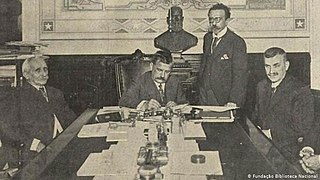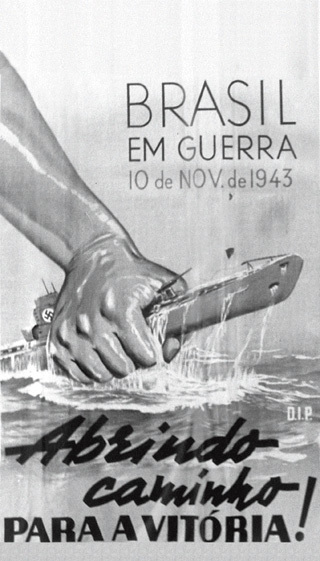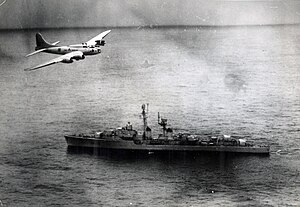
A warship or combatant ship is a ship that is built and primarily intended for naval warfare. Usually they belong to the armed forces of a nation. As well as being armed, warships are designed to withstand damage and are typically faster and more maneuverable than merchant ships. Unlike a merchant ship, which carries cargo, a warship typically carries only weapons, ammunition and supplies for its crew. Warships usually belong to a navy, though they have also been operated by individuals, cooperatives and corporations.

The Argentine Navy is the navy of Argentina. It is one of the three branches of the Armed Forces of the Argentine Republic, together with the Army and the Air Force.
The Brazilian Navy is the naval service branch of the Brazilian Armed Forces, responsible for conducting naval operations.
In the Royal Navy and other navies of Europe and the Commonwealth of Nations, ships are identified by pennant number. Historically, naval ships flew a flag that identified a flotilla or type of vessel. For example, the Royal Navy used a red burgee for torpedo boats and a pennant with an H for torpedo boat destroyers. Adding a number to the type-identifying flag uniquely identified each ship.

The Portuguese Navy is the naval branch of the Portuguese Armed Forces which, in cooperation and integrated with the other branches of the Portuguese military, is charged with the military defense of Portugal.
The Force d'action navale is the 9,600-man and about 100-ship force of surface warships of the French Navy. As of August 2023, it is commanded by L’amiral Nicolas Vaujour.

The Cisplatine War was an armed conflict fought in the 1820s between the Empire of Brazil and the United Provinces of the Río de la Plata over control of Brazil's Cisplatina province. It was fought in the aftermath of the United Provinces' and Brazil's independence from Spain and Portugal, respectively, and resulted in the independence of Cisplatina as the Oriental Republic of Uruguay.

The Brazilian Naval Revolts, or the Revoltas da Armada, were armed mutinies promoted mainly by admirals Custódio José de Melo and Saldanha da Gama and their fleet of rebel Brazilian navy ships against the claimed unconstitutional staying in power of president Floriano Peixoto.

Captain is the name most often given in English-speaking navies to the rank corresponding to command of the largest ships. The rank is equal to the army rank of colonel and air force rank of group captain.

The Free French Naval Forces were the naval arm of the Free French Forces during the Second World War. They were commanded by Admiral Émile Muselier.

Naval trawlers are vessels built along the lines of a fishing trawler but fitted out for naval purposes; they were widely used during the First and Second World Wars. Some—known in the Royal Navy as "Admiralty trawlers"— were purpose-built to naval specifications, others adapted from civilian use. Fishing trawlers were particularly suited for many naval requirements because they were robust vessels designed to work heavy trawls in all types of weather, and had large clear working decks. A minesweeper could be created by replacing the trawl with a mine sweep. Adding depth charge racks on the deck, ASDIC sonar below, and a 3-inch (76 mm) or 4-inch (102 mm) gun in the bow equipped the trawler for anti-submarine duties.

The Armed Forces of the Empire of Brazil were the overall unified military forces of the Empire of Brazil. The Brazilian military was first formed by Emperor Dom Pedro I to defend the new nation against the Portuguese in the Brazilian War of Independence. The Army and Armada were commissioned in 1822 with the objective of defeating and expelling the Portuguese troops from Brazilian soil.

During World War I (1914–1918), Brazil initially adopted a neutral position. They did this in accordance with the Hague Convention, in an attempt to maintain markets for its export products, those being mainly coffee, latex and industrially manufactured items.

Bahia was the lead ship of a two-vessel class of cruisers built for Brazil by the British company Armstrong Whitworth. Crewmen mutinied in November 1910 aboard Bahia, Deodoro, Minas Geraes, and São Paulo, beginning the four-day Revolta da Chibata. Brazil's capital city of Rio de Janeiro was held hostage by the possibility of a naval bombardment, leading the government to give in to the rebel demands which included the abolition of flogging in the navy. During the First World War, Bahia and its sister ship Rio Grande do Sul were assigned to the Divisão Naval em Operações de Guerra, the Brazilian Navy's main contribution in that conflict. The squadron was based in Sierra Leone and Dakar and escorted convoys through an area believed to be heavily patrolled by U-boats.

The Angolan Navy or MGA is the naval branch of the Angolan Armed Forces and is tasked with protecting Angola's 1,600 km long coastline. The Angolan Navy has approximately 1,000 personnel.

Brazil was on the Allied side in World War II (1939–1945) despite the fascist sympathies of its ruling Estado Novo regime. German and Italian submarines torpedoed Brazilian ships in February 1942 in retaliation to Brazil's adherence to the Atlantic Charter, which called for automatic support for any nation on the American continent which was attacked by an extra-continental power. Over several months 36 Brazilian merchant ships were sunk causing a total of 1,691 shipwrecks and 1,074 deaths.

The Imperial Brazilian Navy was the navy created at the time of the independence of the Empire of Brazil from the United Kingdom of Portugal, Brazil and the Algarves. It existed between 1822 and 1889 during the vacancy of the constitutional monarchy.
The Brazilian Navy has a large number of active and planned projects, under the modernization plans of the Brazilian Armed Forces, defined in the National Defense White Paper. From 2010, Brazil started a radical change in its military policy, aiming to consolidate itself as the major power of Latin America, then the country's military strategists saw the great importance in modernize the Navy, both in terms of global projection and deterrence against possible threats to national interests by foreign powers from the year 2040, the total estimated budget for the plan was estimated in US$ 119 billion in 2010.

Dom Afonso was a steam frigate that served the Imperial Brazilian Navy, being the first steamship to serve in this navy. It was built in England under the supervision of chief of squad John Pascoe Grenfell and was named Dom Afonso in honor of Afonso, Prince Imperial of Brazil, son of emperor Pedro II of Brazil and empress Teresa Cristina.

French invasions in Brazil date back to the earliest days of Portuguese colonization up until the end of the 19th century.



















